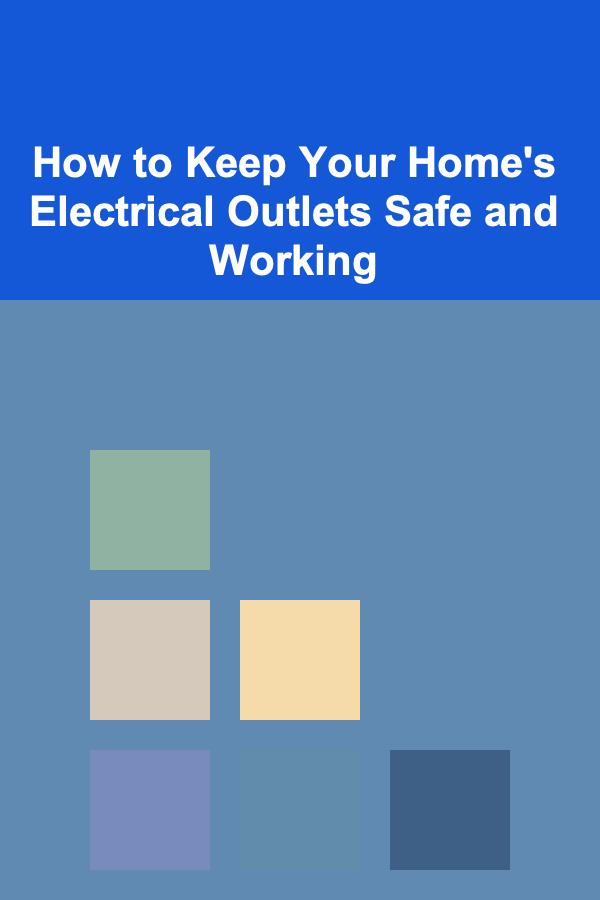
How to Keep Your Home's Electrical Outlets Safe and Working
ebook include PDF & Audio bundle (Micro Guide)
$12.99$5.99
Limited Time Offer! Order within the next:

Electrical outlets are an essential component of any home. They provide the power needed for countless devices, from everyday appliances like refrigerators and lamps to personal electronics like phones and computers. However, these outlets also pose significant risks if not properly maintained or used. Faulty outlets or improper use of electrical systems can result in electric shocks, fires, or long-term damage to appliances. To keep your electrical outlets safe and working effectively, it's important to follow proper usage, maintenance, and safety protocols.
In this article, we'll explore the importance of electrical outlet safety, the potential hazards associated with them, how to maintain and troubleshoot outlets, and how to prevent common electrical problems. Understanding the proper care of your electrical outlets is an essential part of maintaining a safe and functional home.
Understanding Your Home's Electrical System
Before diving into safety practices for electrical outlets, it's crucial to understand the basics of your home's electrical system. In most homes, electrical systems are designed to distribute electricity to various outlets, fixtures, and appliances in a controlled and safe manner. This distribution happens through a network of wires connected to an electrical panel, which acts as the main control center for the entire system.
Your outlets are typically wired into a circuit breaker system. Each breaker controls the flow of electricity to a group of outlets or electrical fixtures. If an issue arises, such as an overloaded circuit or a short circuit, the breaker will trip, cutting off the flow of electricity to prevent damage or fires.
Types of Electrical Outlets
Electrical outlets come in a variety of types and configurations, and each has a specific role. The most common types are:
- Standard 120-volt outlets (Type A and Type B): These are the most commonly found outlets in the United States. Type A outlets have two flat parallel slots, while Type B outlets have two flat parallel slots and a round grounding hole. They are used for everyday devices, such as lamps, phones, and televisions.
- Ground Fault Circuit Interrupter (GFCI) outlets: These outlets are commonly used in areas where electrical shock hazards are high, such as kitchens, bathrooms, and outdoor spaces. They detect any variation in current and immediately shut off the power to prevent shocks.
- Arc Fault Circuit Interrupter (AFCI) outlets: AFCIs are designed to detect arc faults, which can occur when there's a loose or damaged wire. These outlets cut off the electricity if an arc is detected, preventing potential fires.
- 240-volt outlets: Found for high-power appliances such as dryers, stoves, and air conditioners, these outlets provide more voltage for appliances that require a higher power supply.
Safety Hazards Associated with Electrical Outlets
Electrical outlets pose several safety hazards if not properly maintained or used. Some of the most common risks include:
1. Electrical Fires
One of the biggest dangers associated with electrical outlets is the risk of fire. Electrical fires can occur when an outlet becomes overloaded or when faulty wiring causes a short circuit. The heat generated from the overload or short circuit can ignite nearby materials, such as wood, paper, or fabric. In fact, electrical malfunctions are one of the leading causes of house fires.
2. Electric Shock
Electric shocks can occur when people come into contact with exposed electrical components or when outlets are improperly used. The risk of electric shock is particularly high in areas where outlets are exposed to moisture, such as bathrooms or kitchens. This is why GFCI outlets are often required in these spaces.
3. Overloading Outlets
Plugging too many devices into a single outlet can result in overloading, which can cause overheating and potentially lead to fire hazards. Devices with high power demands, such as space heaters or toasters, should not be plugged into the same outlet as other electronics or appliances.
4. Faulty Wiring
Faulty or outdated wiring can cause a range of problems, including overheating, short circuits, and fire risks. Poorly installed outlets or exposed wiring can also present a direct hazard, especially in older homes where electrical systems may not meet modern safety standards.
5. Damaged Outlets
Over time, electrical outlets can become worn out or damaged due to frequent use. Worn-out outlets may not hold plugs properly or could expose wiring, increasing the risk of electric shock or short circuits. Regular inspections are crucial to identify and replace damaged outlets before they cause serious problems.
How to Keep Your Electrical Outlets Safe and Working
Now that we have an understanding of the risks, it's important to focus on how to keep your electrical outlets safe and functioning properly. Here are several steps and practices that can help:
1. Regular Inspections of Outlets
Routine inspections are an essential part of outlet maintenance. Check outlets regularly for signs of damage, such as:
- Burn marks or discoloration around the outlet, which could indicate overheating.
- Loose or wobbly outlets that may not hold plugs securely.
- A burning smell or unusual sounds coming from the outlet, which could be a sign of overheating or electrical issues.
- Exposed wiring or damaged covers that could present shock hazards.
If you notice any of these signs, it's important to address the issue immediately by replacing the outlet or calling a licensed electrician to inspect and repair the system.
2. Use the Right Type of Outlet for Each Area
Not all outlets are suitable for every space. For example, areas like kitchens, bathrooms, and outdoor spaces have a higher risk of electrical hazards due to the presence of water or moisture. In these areas, GFCI outlets should be used to prevent electrical shock. AFCIs are also recommended in areas where there is a risk of arc faults, such as bedrooms or living rooms.
If your home has older outlets that don't meet current safety standards, it's a good idea to upgrade to GFCI or AFCI outlets to enhance safety.
3. Avoid Overloading Outlets
Overloading outlets is a major safety concern. To prevent overloading:
- Plug only one high-power appliance (like a space heater or microwave) into each outlet.
- Avoid using extension cords for permanent setups. While extension cords are useful in temporary situations, they should not be relied upon for continuous use.
- Use a power strip with a built-in circuit breaker if you need to connect multiple devices to a single outlet. Ensure the power strip is rated for the total wattage of the devices you are connecting.
If you notice that an outlet or power strip is warm to the touch or showing signs of strain, unplug devices immediately and reduce the load.
4. Keep Outlets Dry and Clean
Moisture is a significant hazard when it comes to electrical outlets. Always keep outlets dry, particularly in areas like the kitchen and bathroom. Water can increase the risk of electrical shock and short circuits.
To maintain cleanliness:
- Avoid spilling liquids near electrical outlets.
- Make sure all outlets in damp or wet areas are properly grounded and have GFCI protection.
- Use a clean, dry cloth to wipe down the surfaces of outlets, but avoid cleaning them with water or other liquids.
5. Replace Worn or Damaged Outlets Promptly
As mentioned earlier, outlets can become worn out or damaged over time. If you notice any of the following signs, it's time to replace the outlet:
- The outlet is not holding plugs securely.
- You hear buzzing or crackling sounds coming from the outlet.
- The outlet is discolored, hot to the touch, or emitting a burning smell.
- The outlet is physically damaged, with visible cracks or exposed wires.
Replacing damaged outlets is an easy and inexpensive way to ensure that your electrical system remains safe. If you're unsure how to replace an outlet, it's always best to call a licensed electrician to perform the task.
6. Use Childproof Outlets
If you have young children in your home, consider installing childproof outlets or outlet covers. These devices prevent children from inserting objects into the outlet, which can lead to electric shock. Childproof outlets can be a simple yet effective measure to ensure that electrical outlets are safe for your family.
7. Hire a Professional Electrician
While it's important to maintain and troubleshoot outlets on your own, there are certain situations where it's best to hire a professional electrician. A licensed electrician can:
- Inspect your home's electrical system to ensure that everything is up to code.
- Perform repairs and replacements of faulty or outdated wiring.
- Install new outlets and circuit breakers to meet your home's electrical needs.
- Diagnose and fix any electrical issues that you're unable to address yourself.
Always hire a professional if you're unsure about the safety of your electrical system. Electrical work can be complex and dangerous, so it's crucial to leave it to someone with the proper expertise.
8. Be Mindful of Electrical Appliances and Tools
Finally, ensure that the appliances and tools you use with your outlets are in good working condition. Faulty appliances or power tools can cause electrical overloads or short circuits. Always inspect cords, plugs, and devices for signs of wear before use. If you notice any damage, such as exposed wires or frayed cords, replace the appliance or cord immediately.
Conclusion
Electrical outlets are crucial for keeping your home's electrical system running smoothly, but they also come with certain safety risks. By following proper safety practices and regularly maintaining your outlets, you can reduce the chances of electrical hazards and ensure that your outlets remain safe and effective. Regular inspections, proper usage, and addressing any issues promptly can help you avoid costly repairs, protect your home from fires, and keep your family safe from electric shock.
Always remember that when in doubt, it's best to consult a licensed electrician to ensure your electrical outlets are up to code and functioning properly. Keeping your home's electrical system in good shape is one of the most important steps you can take to maintain a safe living environment.
Reading More From Our Other Websites
- [Home Rental Property 101] How to Navigate Local Rental Laws and Regulations
- [Toy Making Tip 101] How to Design a Compact Traveling Toy Workshop for Crafting On‑The‑Go Creations
- [Home Budget 101] How to Save Money on Home Repairs: DIY Tips and Tricks
- [Screen Printing Tip 101] Top & Wood Types That Shine with Screen-Printed Designs
- [Ziplining Tip 101] Best Eco‑Conscious Zipline Operators That Contribute to Local Conservation Projects
- [Personal Care Tips 101] How to Use Hair Oil to Treat Dandruff
- [Trail Running Tip 101] 5 Family-Friendly Trails to Kickstart Your Outdoor Running Adventures
- [Screen Printing Tip 101] Common Mistakes When Setting Up Your Screen Printing Frame (and How to Avoid Them)
- [Stamp Making Tip 101] From Block to Beauty: The Art of Hand-Carved Stamps
- [Digital Decluttering Tip 101] Best Methods to Purge Unused Apps from Smartphones Without Losing Data

How to Plan Family Volunteer Days for Community Service
Read More
How to Use Open Houses to Attract Renters
Read More
How To Plan a Group Hiking Trip
Read More
How To Deal with Imposter Syndrome in Leadership
Read More
10 Tips for Speed Solving Crosswords: From Beginner to Pro
Read More
10 Tips for Printing and Binding Your Own Printable Activity Books
Read MoreOther Products

How to Plan Family Volunteer Days for Community Service
Read More
How to Use Open Houses to Attract Renters
Read More
How To Plan a Group Hiking Trip
Read More
How To Deal with Imposter Syndrome in Leadership
Read More
10 Tips for Speed Solving Crosswords: From Beginner to Pro
Read More